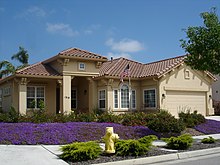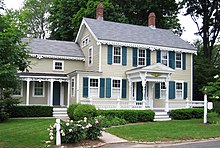FLORIDA BARGAIN HOUSES FOR SALE FROM $99,900
[showcaseidx_hotsheet name=”Bargain_Houses”]
FLORIDA BARGAIN HOUSES FOR SALE FROM $99,900
House



A house is a building that functions as a home, ranging from simple dwellings such as rudimentary huts of nomadic tribes and the improvised shacks in shantytowns to complex, fixed structures of wood, brick, concrete or other materials containing plumbing, ventilation and electrical systems.[1][2] Houses use a range of different roofing systems to keep precipitation such as rain from getting into the dwelling space. Houses may have doors or locks to secure the dwelling space and protect its inhabitants and contents from burglars or other trespassers. Most conventional modern houses in Western cultures will contain one or more bedrooms and bathrooms, a kitchen or cooking area, and a living room. A house may have a separate dining room, or the eating area may be integrated into another room. Some large houses in North America have a recreation room. In traditional agriculture-oriented societies, domestic animals such as chickens or larger livestock (like cattle) may share part of the house with humans. The social unit that lives in a house is known as ahousehold.
Most commonly, a household is a family unit of some kind, although households may also be other social groups, such as roommates or, in a rooming house, unconnected individuals. Some houses only have a dwelling space for one family or similar-sized group; larger houses called townhouses or row houses may contain numerous family dwellings in the same structure. The design and structure of houses is also subject to change as a consequence of globalization, urbanization and other social, economic, demographic, and technological factors. Various other social and cultural factors also influence the building style and patterns of domestic space. A house may be accompanied by outbuildings, such as a garage for vehicles or a shed for gardening equipment and tools. A house may have a backyard or frontyard, which serve as additional areas where inhabitants can relax or eat.
Elements
Layout

Example of an early Victorian“Gingerbread House” in Connecticut, United States, built in 1855
Ideally, architects of houses design rooms to meet the needs of the people who will live in the house. Such designing, known as “interior design“, has become a popular subject in universities. Feng shui, originally a Chinese method of moving houses according to such factors as rain and micro-climates, has recently expanded its scope to address the design of interior spaces, with a view to promoting harmonious effects on the people living inside the house, although no actual effect has ever been demonstrated. Feng shui can also mean the “aura” in or around a dwelling, making it comparable to the real-estate sales concept of “indoor-outdoor flow”.
The square footage of a house in the United States reports the area of “living space”, excluding the garage and other non-living spaces. The “square metres” figure of a house in Europe reports the area of the walls enclosing the home, and thus includes any attached garage and non-living spaces.[citation needed] The number of floors or levels making up the house can affect the square footage of a home.
Parts[edit]
Many houses have several large rooms with specialized functions and several very small rooms for other various reasons. These may include a living/eating area, a sleeping area, and (if suitable facilities and services exist) separate or combined washing and lavatoryareas. Some larger properties may also feature rooms such as a spa room, indoor pool, indoor basketball court, and other ‘non-essential’ facilities. In traditional agriculture-oriented societies, domestic animals such as chickens or larger livestock (like cattle) often share part of the house with human beings. Most conventional modern houses will at least contain a bedroom, bathroom, kitchen or cooking area, and a living room. A typical “foursquare house” (as pictured) occurred commonly in the early history of the US where they were mainly built, with a staircase in the center of the house, surrounded by four rooms, and connected to other sections of the home (including in more recent eras a garage).
History of the interior

Floor plan of a “foursquare” house
Little is known about the earliest origin of the house and its interior, but it can be traced back to the simplest form of shelters. Romanarchitect Vitruvius‘ theories have claimed the first form of architecture as a frame of timber branches finished in mud, also known as theprimitive hut.[5] Philip Tabor later states the contribution of 17th century Dutch houses as the foundation of houses today.
- “As far as the idea of the home is concerned, the home of the home is the Netherlands. This idea’s crystallization might be dated to the first three-quarters of the 17th century, when the Dutch Netherlands amassed the unprecedented and unrivalled accumulation of capital, and emptied their purses into domestic space.[6]



